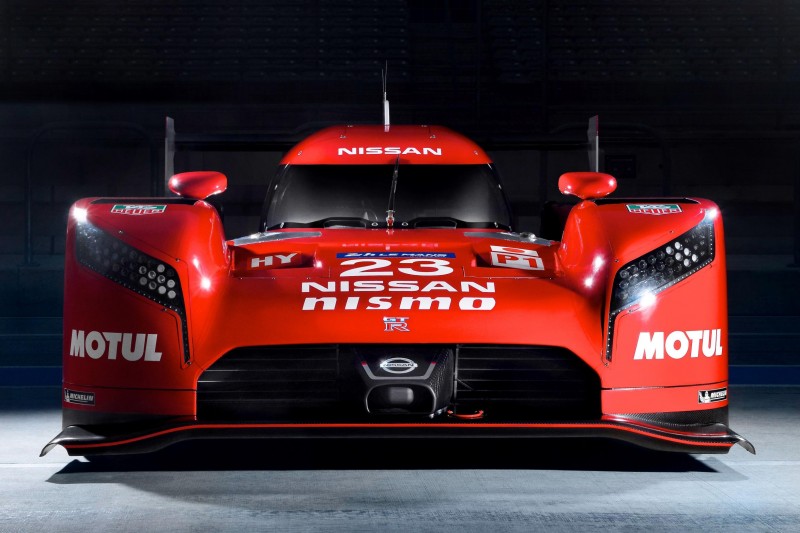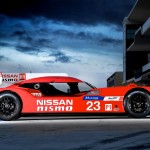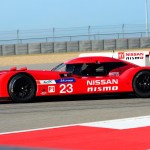Nissan has revealed its Le Mans challenger – the Nissan GT-R LM NISMO – during the Super Bowl XLIX commercial break.
The Japanese manufacturer has interpreted the sport’s technical regulations in an innovative way, producing a front-engined, front wheel drive car that is powered by a V6 3-litre twin turbo petrol engine and a kinetic energy recovery system (KERS), designed by Briton Ben Bowlby. Bowlby is the man behind the now infamous delta-wing design, which saw use at Le Mans last year, in the form of the ZEOD RC.
The new car will contest the LMP1 class of the FIA World Endurance Championship, the highest category in world sports car racing. Starting at Silverstone, UK on 12 April the series travels around the world to Spa in Belgium, onto the Le Mans 24 Hours and Germany’s Nurburgring, before going global with races in the US, Japan, China and the Middle East.
The 2014 season was dominated by the Toyota team, who showed their worth throughout the season and took outright victory. However, Audi managed to maintain their immaculate Le Mans 24 Hour victory and took victory there, much to the annoyance of the Japanese team. 2014 also saw the reintroduction of Porsche to the race series, who entered the contest with an impressive machine. However, they were unable to capitalise against such strong competition set forth by Toyota and Audi.
2015 will see Toyota, Audi, Porsche and now Nissan struggle for position although the Nissan is arguably the most radical of all the cars out on track. At 15 feet long and 6 feet wide, it represents a large obstacle for others to consider overtaking. What will make their task more difficult, is the Nissan’s extreme amount of power.
The Nissan GT-R LM NISMO was originally destined to have around 2,000hp. However, through development of the powertrain, that figure has been shrunk to between 1250-1500hp. The petrol powered V6 contributes more than 500hp, while the 8MJ H Flybrid system delivers around 750hp. 8MJ means a not insignificant eight meja-Joules of energy. This flybrid system differs from others on track since it provides so much power and near instant torque to such an extent that should it fail, it would reduce the car from beast to mouse in a mere instant. Toyota employ a 6MJ system, while Audi employ a much more modest 2MJ system. Each have their pros and cons, although the 8MJ could be called ambitious, to say the least. Torotrak, the makers of the Flybrid system (after the company was purchased in 2014) produce many different flywheel based Energy Recovery Systems (ERS). To find out more about Flybrid and how their systems work, AutoVolt covered them in our bimonthly technology piece in the July 2014 edition; see here.
Because of the amount of power being sent through the front wheels, another interesting quirk of the car’s is that its front tyres are wider than the rears. Torque steer is overcome by the use of aerodynamics which are critical to the sure-footedness of the car on the track.
The FIA World Endurance Championship is the ultimate proving ground for automotive companies as technological gains on the track can carry through to road cars. Racing car engineers are facing the same challenges as road car engineers as the spotlight falls on energy efficiency. With more technical freedom than Formula 1, the LMP1 engineers have ample opportunity to innovate. Shoichi Miyatani, President of NISMO, said:
“This is innovation that excites. Sustainability is at the top of our agenda and the technical regulations for Le Mans give us the freedom to pursue new ideas in this area. Our record at Le Mans is third place overall so we have unfinished business there. We want to win and we have the knowledge to do that – for our customers, our employees and our fans. The competition is exceptionally strong and we are excited by the challenge.”
Darren Cox, Global Head of Brand, Marketing & Sales, NISMO, implied that new technologies may yet make their way into road going NISMO cars. Perhaps the next Nissan GT-R will feature a race proven flybrid system? He said:
“We are taking motorsport to the masses, telling tales of technical innovation but also human stories via all of the exciting communications channels that are open to us now. We will innovate off the track as well as on it so you can be assured that this is just the beginning of the story.”
The intensive test programme for the Nissan GT-R LM NISMO that began in Arizona last year continues this week at the Circuit of the Americas in Texas, where the team is making the most of the warmer Southern US climate. The first of Nissan’s LMP1 drivers has been revealed as Marc Gené. The Spaniard is no stranger to the 24h of Le Mans, as he won the prestigious event on only his third attempt.
Source; Nissan






